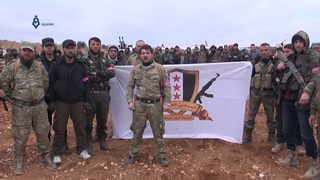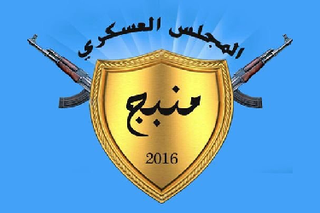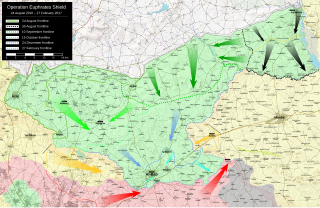
The People's Defense Units (YPG), also called People's Protection Units, is a mainly Kurdish militant group in Syria and the primary component of the Syrian Democratic Forces (SDF).

The Autonomous Administration of North and East Syria (AANES), also known as Rojava, is a de facto autonomous region in northeastern Syria. It consists of self-governing sub-regions in the areas of Afrin, Jazira, Euphrates, Raqqa, Tabqa, Manbij, and Deir Ez-Zor. The region gained its de facto autonomy in 2012 in the context of the ongoing Rojava conflict and the wider Syrian civil war, in which its official military force, the Syrian Democratic Forces (SDF), has taken part.

Turkey's involvement in the Syrian Civil War began diplomatically and later escalated militarily. Initially, Turkey condemned the Syrian government at the outbreak of civil unrest in Syria during the spring of 2011; the Turkish government's involvement gradually evolved into military assistance for the Free Syrian Army in July 2011, border clashes in 2012, and direct military interventions in 2016–17, in 2018, in 2019, 2020, and in 2022. The military operations have resulted in the Turkish occupation of northern Syria since August 2016.

The Women's Protection Units or Women's Defense Units is an all-female militia involved in the Syrian civil war. The YPJ is part of the Syrian Democratic Forces, the armed forces of Rojava, and is closely affiliated with the male-led YPG. While the YPJ is mainly made up of Kurds, it also includes women from other ethnic groups in Northern Syria.

AANES–Syria relations concern the military and political relations between the Ba'athist Syrian Arab Republic and the Autonomous Administration of North and East Syria (NES), a de facto autonomous multi-ethnic region in northern and eastern Syria. The Syrian government does not officially recognise the autonomy of the AANES, and advocates a centralist approach to the governance of Syria. The NES seeks the federalisation of Syria. For most of the Syrian civil war, there has been a non-aggression pact between the military of Syria and the Syrian Democratic Forces, with occasional confrontations and some cooperation against Islamist groups, in particular against the Turkish Armed Forces and the Turkish-backed Syrian National Army. While the two sides co-operated militarily under Russian supervision since 2019, with Syrian and Russian troops stationed along the Turkish border to prevent further advances, political negotiations have ended in failure. The Syrian government has no authority or institutions in North and East Syria outside of its two security boxes in Qamishli/Qamislo and Al-Hasakah/Heseke. The Autonomous Administration does not allow the Syrian Government to hold elections in areas under its control.

The Syrian Democratic Forces (SDF) is a coalition formed by ethnic militias and rebel groups, and serves as the official military wing of the Autonomous Administration of North and East Syria (AANES). The SDF is allied to and supplied by the United States–led CJTF–OIR international alliance. Founded in 10 October 2015, the SDF claims that its mission is fighting to create a secular, democratic and federalised Syria. The SDF is opposed by Turkey, who claims the group has direct links to the PKK, which it recognizes as a terrorist group.

The Manbij Military Council (MMC) is a coalition established by several groups in the Syrian Democratic Forces (SDF), primarily the Northern Sun Battalion, on 2 April 2016 at the Tishrin Dam on the Euphrates. The MMC led the SDF's Manbij offensive from June 2016 that led to the capture of the city of Manbij from the Islamic State of Iraq and the Levant two months later. Most fighters in the MMC are from Manbij and the surrounding areas.

The Shahba Canton is a political unit of the Autonomous Administration of North and East Syria, in the Aleppo Governorate. The canton was established to administer the areas captured by the Syrian Democratic Forces from the Islamic State of Iraq and the Levant west of the Euphrates, as part of the Afrin Region.
Arima, also spelled Orayma or Arimah, is a town and seat of a subdistrict (nahiya) in Al-Bab District, located 20 kilometers (12 mi) northeast of the city of al-Bab and 65 kilometers (40 mi) northeast of Aleppo in northern Syria. In the 2004 census, it had a population of 2,839. The town of Qabasin is also to the south-west, and closer than Al-Bab. Manbij city is to the north-east. In course of the Syrian Civil War, the town repeatedly changed hands. As of 2020, it was under dual control of the Syrian government and the Autonomous Administration of North and East Syria (AANES).

Mansur Selum is an Arab politician. Since March 2016, he holds the office of co-president of the Executive Council of Rojava. Selum, serves alongside fellow co-president Îlham Ehmed, an ethnic Kurd.

Operation Euphrates Shield was a cross-border military operation conducted by the Turkish Armed Forces in the Syrian Civil War which led to the Turkish occupation of northern Syria. Operations were carried out in the region between the Euphrates river to the east and the rebel-held area around Azaz to the west. The Turkish military and Turkey-aligned Syrian rebel groups, some of which used the Free Syrian Army label, fought against the forces of the Islamic State (IS) as well as against the Syrian Democratic Forces (SDF) from 24 August 2016. On 29 March 2017, the Turkish military officially announced that Operation Euphrates Shield was "successfully completed".

The Turkish Armed Forces and its ally the Syrian National Army have occupied areas of northern Syria since August 2016, during the Syrian Civil War. Though these areas nominally acknowledge a government affiliated with the Syrian opposition, in practice they constitute a separate proto-state under the dual authority of decentralized native local councils and Turkish military administration.
The following is a timeline of the Syrian Civil War from January to April 2018. Information about aggregated casualty counts is found at Casualties of the Syrian Civil War.
The following is a timeline of the Syrian Civil War from September to December 2018. Information about aggregated casualty counts is found at Casualties of the Syrian Civil War.

The 2018 Syrian-Turkish border clashes began on 31 October 2018 when the Turkish Armed Forces began to shell People's Protection Units (YPG) positions near the cities of Kobani and Tell Abyad as well as surrounding villages. Turkey views the YPG as an extension of the outlawed Kurdistan Workers' Party (PKK), which has been waging an insurgency in Turkey for over 40 years.
The 2019 Tell Rifaat Clashes were a military confrontation between Turkey and allied Free Syrian Army groups against the Kurdish People's Protection Units (YPG) in early May 2019.

The Northern Syria Buffer Zone was a temporary Syrian Civil War demilitarized zone (DMZ) established on the Syrian side of the Syria–Turkey border in August 2019 to maintain security along the border and to dissuade a prospective Turkish invasion of the self-proclaimed Autonomous Administration of North and East Syria. The DMZ was administered by the Kurdish-led Syrian Democratic Forces (SDF) and their military councils and enforced by United States Armed Forces and Turkish Armed Forces personnel.

The 2019 Turkish offensive into north-eastern Syria, code-named Operation Peace Spring by Turkey, was a cross-border military operation conducted by the Turkish Armed Forces (TSK) and the Syrian National Army (SNA) against the Syrian Democratic Forces (SDF) and later Syrian Arab Army (SAA) in northern Syria.

The Second Northern Syria Buffer Zone, part of the Sochi Agreement, is a buffer zone in northern Syria between the Turkish Armed Forces (TAF) and the Syrian Democratic Forces (SDF). It was set up following a memorandum of understanding in the Russian city Sochi on 22 October 2019 by the Russian and Turkish presidents during the 2019 Turkish offensive into north-eastern Syria. Most of the zone is controlled by the Syrian Army and Russian Military Police, and some by the TAF.
2010s in Syria political history refers to events during the 2010s in political history of Syria.















